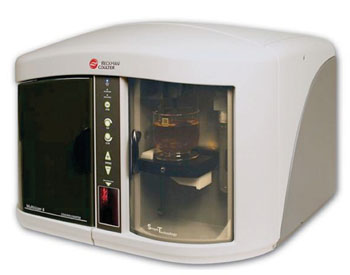Blood Iron Test Predicts Fatal Outcomes
|
By LabMedica International staff writers Posted on 14 Apr 2014 |

Image: The Coulter Electronic Counter (Photo courtesy of Beckman Coulter).
The transferrin saturation (TSAT) ratio is a commonly used indicator of iron deficiency and iron overload in clinical practice, but precise relationships with total and cardiovascular mortality are equivocal.
The test is a measure of the amount of available iron in the bloodstream with low levels generally reflecting a state of iron deficiency and high levels suggesting a relative excess which can be detrimental to health.
Scientists at the University of Limerick (Ireland) studied 15,823 participants, 20 years of age or older, who had a valid serum creatinine value. Serum creatinine values were used to determine the estimated glomerular filtration rate (eGFR) in mL/min/1.73 m2 for all participants. Blood samples were obtained from nonfasting persons and frozen serum sent for analysis.
Serum iron and total iron binding capacity were measured colorimetrically (Alpkem RFA analyzer; Clackamas, OR, USA), and serum ferritin was measured with the Quantimmune IRMA kit (Bio-Rad Laboratories; Hercules, CA, USA). Hemoglobin was measured using a Coulter S-Plus Jr electronic counter (Coulter Electronics; Hialeah, FL, USA). Serum creatinine concentrations were measured by the modified kinetic Jaffe reaction using a Hitachi 737 analyzer (Boehringer Mannheim Corp.; Indianapolis, IN, USA).
The study found that subjects with extremely low transferrin saturation levels of less that 17.5% were at a 45% higher risk of death. On the other hand, the risk of death was also significantly higher for subjects with very high levels of transferrin saturation above 31.3 %. The mean values for TSAT were 26.3 %; hemoglobin 14.2 g/dL and serum ferritin level 129 ng/mL. The association of TSAT with mortality differed by race and sex. Among whites and blacks, low and high TSAT levels were associated with higher mortality risk while no association was manifest in Mexican-Americans. For men, the impact on mortality was demonstrated only in older males, while for women the j-shaped mortality association was confined to younger females. High levels usually occur in states of iron overload like hemochromatosis, multiple blood transfusions and cirrhosis.
Austin G. Stack MD MSc, a professor and senior author of the study said, “Our analysis suggests that the optimal transferrin saturation range for patient survival should be between 23% to 40% and that careful clinical assessment is warranted for patients with low and high levels in order to identify states of iron deficiency or iron excess. Our study demonstrates that transferrin saturation ratio is a useful prognostic tool in assessing a patient's health and while we support the correction of low transferrin saturation levels in the general population, we would also advise caution against excessive iron loading to levels beyond 40%.” The study was published on March 5, 2014, in the Quarterly Journal of Medicine.
Related Links:
University of Limerick
Alpkem
Bio-Rad
The test is a measure of the amount of available iron in the bloodstream with low levels generally reflecting a state of iron deficiency and high levels suggesting a relative excess which can be detrimental to health.
Scientists at the University of Limerick (Ireland) studied 15,823 participants, 20 years of age or older, who had a valid serum creatinine value. Serum creatinine values were used to determine the estimated glomerular filtration rate (eGFR) in mL/min/1.73 m2 for all participants. Blood samples were obtained from nonfasting persons and frozen serum sent for analysis.
Serum iron and total iron binding capacity were measured colorimetrically (Alpkem RFA analyzer; Clackamas, OR, USA), and serum ferritin was measured with the Quantimmune IRMA kit (Bio-Rad Laboratories; Hercules, CA, USA). Hemoglobin was measured using a Coulter S-Plus Jr electronic counter (Coulter Electronics; Hialeah, FL, USA). Serum creatinine concentrations were measured by the modified kinetic Jaffe reaction using a Hitachi 737 analyzer (Boehringer Mannheim Corp.; Indianapolis, IN, USA).
The study found that subjects with extremely low transferrin saturation levels of less that 17.5% were at a 45% higher risk of death. On the other hand, the risk of death was also significantly higher for subjects with very high levels of transferrin saturation above 31.3 %. The mean values for TSAT were 26.3 %; hemoglobin 14.2 g/dL and serum ferritin level 129 ng/mL. The association of TSAT with mortality differed by race and sex. Among whites and blacks, low and high TSAT levels were associated with higher mortality risk while no association was manifest in Mexican-Americans. For men, the impact on mortality was demonstrated only in older males, while for women the j-shaped mortality association was confined to younger females. High levels usually occur in states of iron overload like hemochromatosis, multiple blood transfusions and cirrhosis.
Austin G. Stack MD MSc, a professor and senior author of the study said, “Our analysis suggests that the optimal transferrin saturation range for patient survival should be between 23% to 40% and that careful clinical assessment is warranted for patients with low and high levels in order to identify states of iron deficiency or iron excess. Our study demonstrates that transferrin saturation ratio is a useful prognostic tool in assessing a patient's health and while we support the correction of low transferrin saturation levels in the general population, we would also advise caution against excessive iron loading to levels beyond 40%.” The study was published on March 5, 2014, in the Quarterly Journal of Medicine.
Related Links:
University of Limerick
Alpkem
Bio-Rad
Latest Clinical Chem. News
- POC Breath Diagnostic System to Detect Pneumonia-Causing Pathogens
- Online Tool Detects Drug Exposure Directly from Patient Samples
- Chemical Imaging Probe Could Track and Treat Prostate Cancer
- Mismatch Between Two Common Kidney Function Tests Indicates Serious Health Problems
- VOCs Show Promise for Early Multi-Cancer Detection
- Portable Raman Spectroscopy Offers Cost-Effective Kidney Disease Diagnosis at POC
- Gold Nanoparticles to Improve Accuracy of Ovarian Cancer Diagnosis
- Simultaneous Cell Isolation Technology Improves Cancer Diagnostic Accuracy
- Simple Non-Invasive Hair-Based Test Could Speed ALS Diagnosis
- Paper Strip Saliva Test Detects Elevated Uric Acid Levels Without Blood Draws
- Prostate Cancer Markers Based on Chemical Make-Up of Calcifications to Speed Up Detection
- Breath Test Could Help Detect Blood Cancers
- ML-Powered Gas Sensors to Detect Pathogens and AMR at POC
- Saliva-Based Cancer Detection Technology Eliminates Need for Complex Sample Preparation
- Skin Swabs Could Detect Parkinson’s Years Before Symptoms Appear
- New Clinical Chemistry Analyzer Designed to Meet Growing Demands of Modern Labs

Channels
Molecular Diagnostics
view channel
Rapid Diagnostic Breakthrough Simultaneously Detects Resistance and Virulence in Klebsiella Pneumoniae
Antibiotic resistance is a steadily escalating threat to global healthcare, making common infections harder to treat and increasing the risk of severe complications. One of the most concerning pathogens... Read more
DNA Detection Platform Enables Real-Time Molecular Detection
A next-gen DNA detection platform enables real-time molecular detection by detecting nucleic acids directly without enzymes or thermocyclers, thereby slashing costs, reducing complexity, and boosting reliability... Read moreHematology
view channel
MRD Tests Could Predict Survival in Leukemia Patients
Acute myeloid leukemia is an aggressive blood cancer that disrupts normal blood cell production and often relapses even after intensive treatment. Clinicians currently lack early, reliable markers to predict... Read more
Platelet Activity Blood Test in Middle Age Could Identify Early Alzheimer’s Risk
Early detection of Alzheimer’s disease remains one of the biggest unmet needs in neurology, particularly because the biological changes underlying the disorder begin decades before memory symptoms appear.... Read more
Microvesicles Measurement Could Detect Vascular Injury in Sickle Cell Disease Patients
Assessing disease severity in sickle cell disease (SCD) remains challenging, especially when trying to predict hemolysis, vascular injury, and risk of complications such as vaso-occlusive crises.... Read more
ADLM’s New Coagulation Testing Guidance to Improve Care for Patients on Blood Thinners
Direct oral anticoagulants (DOACs) are one of the most common types of blood thinners. Patients take them to prevent a host of complications that could arise from blood clotting, including stroke, deep... Read moreImmunology
view channel
Blood Test Could Identify Colon Cancer Patients to Benefit from NSAIDs
Colon cancer remains a major cause of cancer-related illness, with many patients facing relapse even after surgery and chemotherapy. Up to 40% of people with stage III disease experience recurrence, highlighting... Read moreBlood Test Could Detect Adverse Immunotherapy Effects
Immune checkpoint inhibitors have transformed cancer treatment, but they can also trigger serious immune-related adverse events that damage healthy organs and may become life-threatening if not detected early.... Read moreMicrobiology
view channel
Breakthroughs in Microbial Analysis to Enhance Disease Prediction
Microorganisms shape human health, ecosystems, and the planet’s climate, yet identifying them and understanding how they are related remains a major scientific challenge. Even with modern DNA sequencing,... Read more
Blood-Based Diagnostic Method Could Identify Pediatric LRTIs
Lower-respiratory tract infections (LRTIs) are a leading cause of illness and death worldwide, and pneumonia is the leading infectious cause of death in children under five, claiming the lives of over... Read morePathology
view channel
Rapid Low-Cost Tests Can Prevent Child Deaths from Contaminated Medicinal Syrups
Medicinal syrups contaminated with toxic chemicals have caused the deaths of hundreds of children worldwide, exposing a critical gap in how these products are tested before reaching patients.... Read more
Tumor Signals in Saliva and Blood Enable Non-Invasive Monitoring of Head and Neck Cancer
Head and neck cancers are among the most aggressive malignancies worldwide, with nearly 900,000 new cases diagnosed each year. Monitoring these cancers for recurrence or relapse typically relies on tissue... Read more
Common Health Issues Can Influence New Blood Tests for Alzheimer’s Disease
Blood-based tests for Alzheimer’s disease are transforming diagnosis by offering a simpler alternative to spinal taps and brain imaging. However, many people evaluated at memory clinics also live with... Read more
Blood Test Formula Identifies Chronic Liver Disease Patients with Higher Cancer Risk
Chronic liver disease affects millions worldwide and can progress silently to hepatocellular carcinoma (HCC), one of the deadliest cancers globally. While surveillance guidelines exist for patients with... Read moreTechnology
view channel
Machine Learning Models Diagnose ALS Earlier Through Blood Biomarkers
Amyotrophic lateral sclerosis (ALS) is a rapidly progressive neurodegenerative disease that is notoriously difficult to diagnose in its early stages. Early symptoms often overlap with other neurological... Read more
Artificial Intelligence Model Could Accelerate Rare Disease Diagnosis
Identifying which genetic variants actually cause disease remains one of the biggest challenges in genomic medicine. Each person carries tens of thousands of DNA changes, yet only a few meaningfully alter... Read moreIndustry
view channel
BD and Penn Institute Collaborate to Advance Immunotherapy through Flow Cytometry
BD (Becton, Dickinson and Company, Franklin Lakes, NJ, USA) has entered into a strategic collaboration with the Institute for Immunology and Immune Health (I3H, Philadelphia, PA, USA) at the University... Read more




















